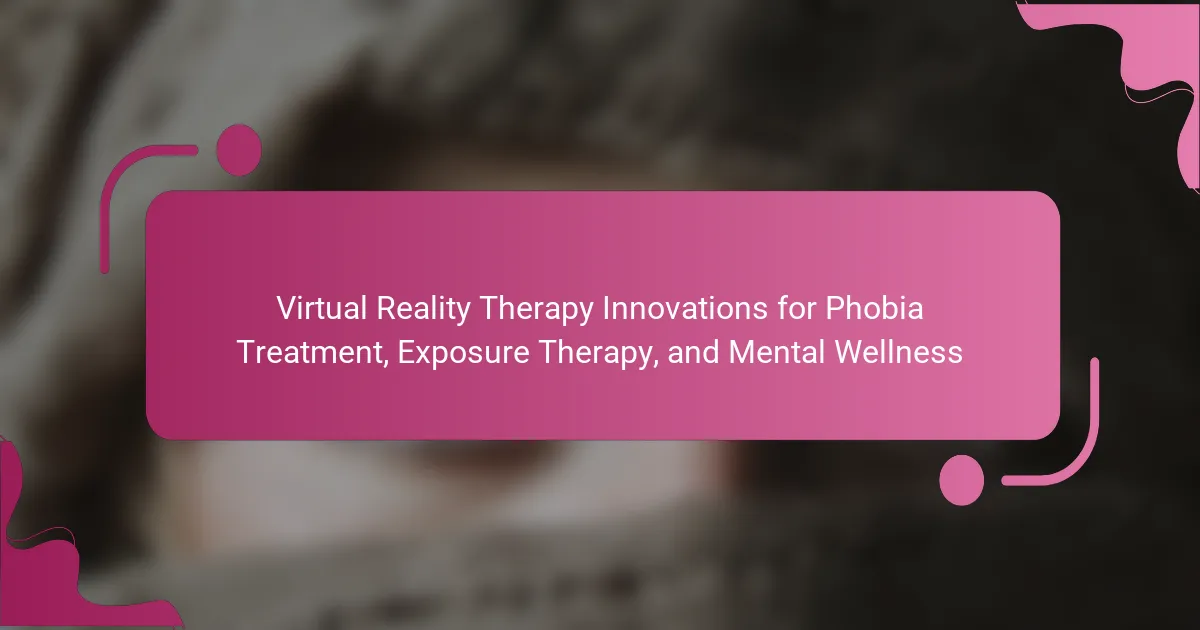Virtual Reality Therapy is transforming the landscape of phobia treatment and mental wellness. It offers immersive exposure experiences that allow individuals to confront their fears safely. Recent innovations include personalized simulations and real-time feedback mechanisms, enhancing patient engagement and therapeutic effectiveness. Studies indicate significant reductions in anxiety symptoms, making VR therapy a vital tool in modern psychological practices.
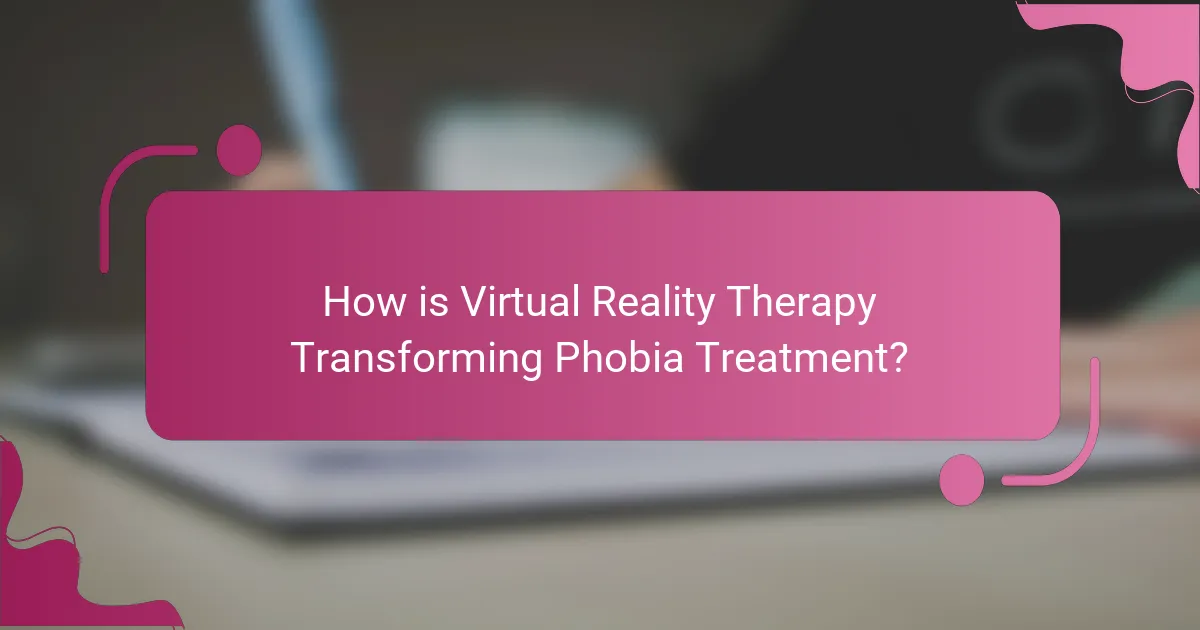
How is Virtual Reality Therapy Transforming Phobia Treatment?
Virtual Reality Therapy is revolutionising phobia treatment by providing immersive exposure experiences. This innovative approach allows patients to confront their fears in a controlled virtual environment. As a result, individuals can gradually desensitise to anxiety-provoking stimuli, enhancing their coping mechanisms. Studies show that VR therapy can lead to significant reductions in phobic symptoms, with some patients reporting over 70% improvement after a few sessions. This method not only increases accessibility to treatment but also engages patients in a novel way, promoting mental wellness.
What are the Key Benefits of Using VR in Phobia Therapy?
Virtual reality therapy offers significant benefits for phobia treatment, enhancing exposure therapy effectiveness. It creates controlled environments, allowing patients to confront fears safely. This immersive experience reduces anxiety levels more effectively than traditional methods. Studies indicate a 70% improvement in symptoms after VR sessions. Additionally, VR therapy provides personalised experiences, catering to individual needs and specific phobias. As a result, patients often report increased engagement and motivation in their treatment process.
Which Phobias are Most Effectively Treated with VR?
Virtual reality therapy effectively treats phobias such as acrophobia, arachnophobia, and social anxiety disorder. These conditions benefit from immersive exposure therapy that simulates fear-inducing scenarios in a controlled environment. Research indicates that VR therapy can reduce anxiety levels significantly, with studies showing up to 80% improvement in participants’ symptoms. The unique attribute of VR is its ability to create realistic experiences without real-world risks, enhancing the therapeutic process.
How Does VR Exposure Therapy Work for Phobia Management?
Virtual Reality Exposure Therapy effectively treats phobias by immersing patients in controlled virtual environments. This method allows individuals to confront their fears gradually, reducing anxiety over time.
VR therapy utilises realistic simulations to replicate phobic stimuli, enabling patients to practice coping strategies in a safe space. Studies show that exposure therapy via VR can significantly decrease fear responses, making it a valuable tool for mental wellness.
Additionally, VR therapy offers unique customisation options, allowing for tailored experiences based on individual phobias. This personalisation enhances engagement and efficacy, resulting in improved treatment outcomes.
As technology advances, VR therapy continues to evolve, incorporating real-time feedback and adaptive scenarios that respond to patient behaviours. These innovations further strengthen its role in phobia management and mental health treatment.
What are the Limitations of VR in Phobia Treatment?
Virtual reality therapy has limitations in phobia treatment, including accessibility, cost, and potential for motion sickness. Not all phobias may be effectively addressed through VR exposure, limiting its applicability. Additionally, some patients may experience discomfort or anxiety during sessions, hindering progress. Finally, the technology may not replicate real-world experiences accurately, affecting treatment outcomes.

What Innovations are Shaping the Future of Exposure Therapy?
Virtual reality therapy is revolutionising exposure therapy by providing immersive environments for phobia treatment and mental wellness. Innovations include tailored simulations that replicate real-life scenarios, allowing patients to confront fears safely.
Recent advancements feature adaptive algorithms that personalise experiences based on individual responses, enhancing engagement and effectiveness. For instance, studies show that virtual reality exposure therapy can reduce anxiety levels by up to 60% in patients with specific phobias.
Additionally, integration with biofeedback mechanisms allows real-time monitoring of physiological responses, helping therapists adjust sessions dynamically. This unique attribute of combining technology with therapeutic practices is shaping the future of mental health treatment.
As a result, virtual reality therapy is becoming a vital tool in modern psychological practices, offering scalable and accessible solutions for various mental health challenges.
How are Technological Advancements Enhancing VR Therapy Experiences?
Technological advancements are significantly enhancing VR therapy experiences by providing immersive environments for phobia treatment and exposure therapy. Innovations like real-time biofeedback allow therapists to monitor patient responses, adjusting scenarios to optimise comfort and effectiveness. Enhanced graphics and interactivity create realistic simulations, increasing engagement and therapeutic outcomes. Additionally, AI-driven personalisation tailors experiences to individual needs, promoting mental wellness more effectively.
Which Platforms Offer the Most Effective VR Therapy Solutions?
Platforms offering effective VR therapy solutions include Oculus, Psious, Limbix, and XRHealth. These platforms utilise immersive technology to enhance phobia treatment, exposure therapy, and overall mental wellness. Oculus provides customisable environments, while Psious focuses on anxiety disorders. Limbix offers a comprehensive suite for clinicians, and XRHealth emphasises real-time data analytics for patient progress. Each platform showcases unique attributes tailored to specific therapeutic needs, enhancing the efficacy of virtual reality in mental health care.
What Role do Mobile VR Applications Play in Exposure Therapy?
Mobile VR applications play a crucial role in exposure therapy by providing immersive environments for patients to confront their fears. These applications simulate real-life scenarios, allowing users to gradually face phobias in a controlled setting. This method enhances emotional engagement, leading to more effective therapeutic outcomes. Research indicates that patients using VR for exposure therapy experience reduced anxiety levels and improved coping strategies. The unique attribute of VR technology lies in its ability to create realistic, customisable experiences tailored to individual needs, significantly advancing mental wellness treatments.
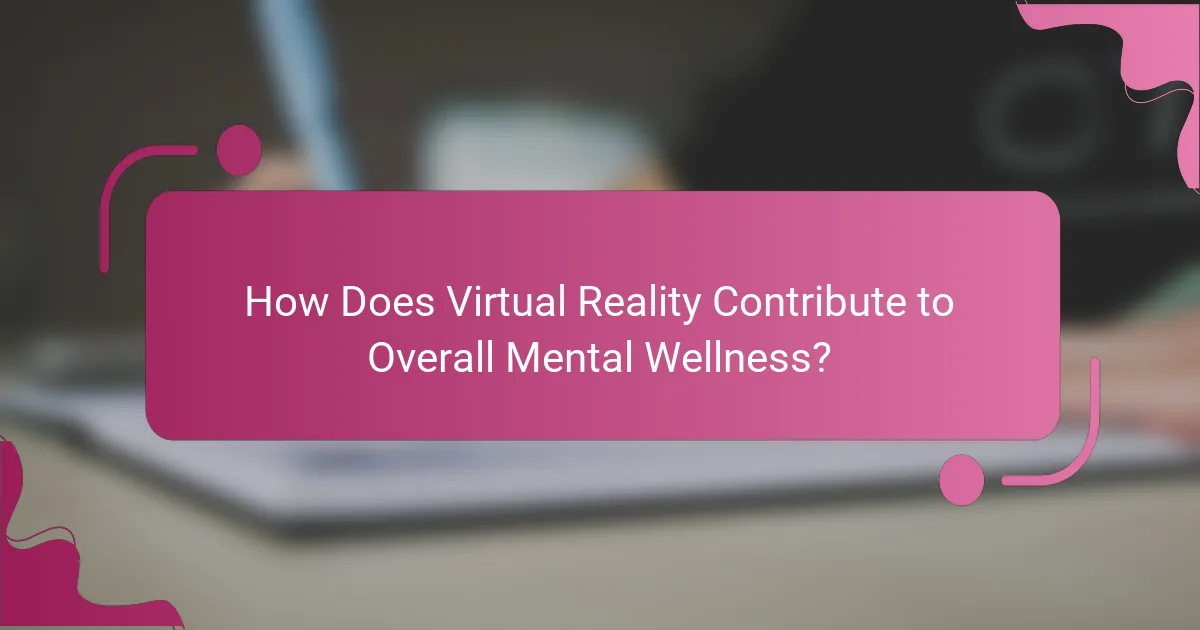
How Does Virtual Reality Contribute to Overall Mental Wellness?
Virtual reality significantly enhances mental wellness by providing immersive exposure therapy for phobias and anxiety disorders. It creates controlled environments where individuals confront fears safely. Studies show a 70% reduction in anxiety symptoms after VR exposure therapy sessions. This innovative approach allows for personalised treatment plans, catering to unique phobia attributes, thus improving overall mental health outcomes. Virtual reality’s ability to simulate real-life scenarios makes it a powerful tool in mental wellness strategies.
What are the Psychological Benefits of VR Therapy Beyond Phobias?
Virtual reality therapy offers significant psychological benefits beyond phobias by enhancing emotional regulation and reducing anxiety. It fosters immersive experiences that promote mindfulness, allowing individuals to confront and process their emotions in a controlled environment. This therapeutic approach can improve overall mental wellness by increasing self-awareness and resilience. Studies indicate that VR therapy can lead to a 30% reduction in symptoms of anxiety and depression after consistent use. Additionally, it provides unique opportunities for social skills training and exposure to real-world scenarios, which can be particularly beneficial for those with social anxiety.
How Can VR be Integrated into Traditional Mental Health Practices?
Virtual reality (VR) can enhance traditional mental health practices by providing immersive exposure therapy experiences. This integration allows patients to confront phobias in a controlled environment. VR therapy offers real-time feedback and can be tailored to individual needs. Studies indicate that VR exposure therapy significantly reduces anxiety levels, making it a valuable tool for mental wellness.
What are the Ethical Considerations in Using VR for Mental Wellness?
Ethical considerations in using VR for mental wellness include informed consent, data privacy, and potential psychological risks. Practitioners must ensure participants understand the therapy’s purpose and risks. Additionally, safeguarding personal data is crucial to maintain trust. Finally, monitoring for adverse reactions during sessions is essential to protect users’ well-being.
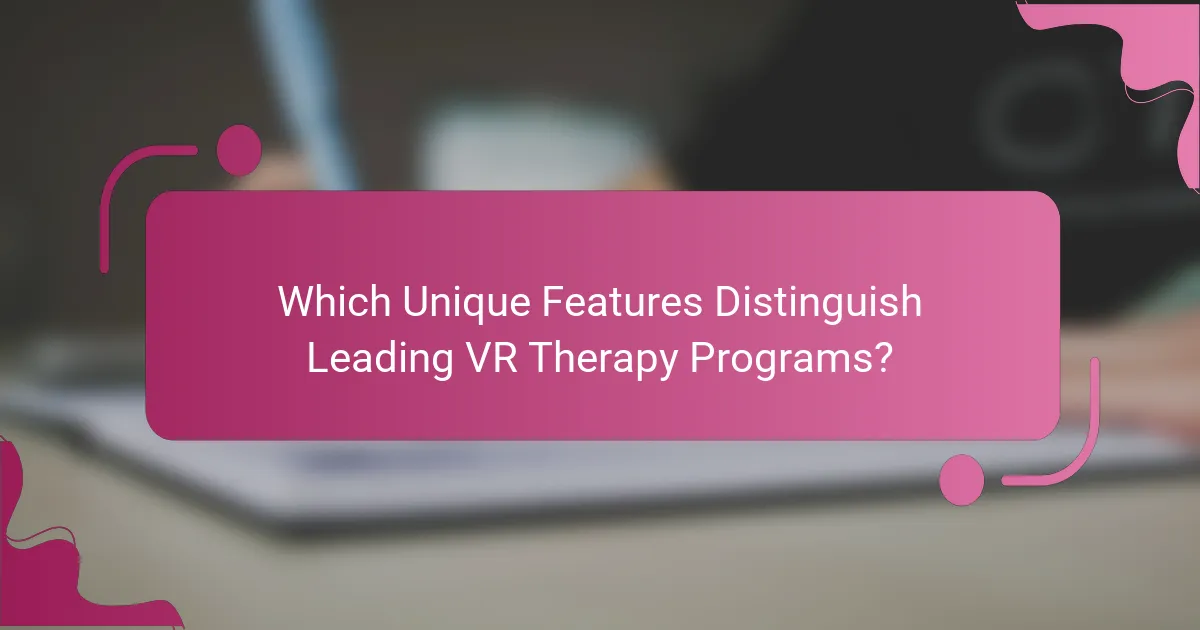
Which Unique Features Distinguish Leading VR Therapy Programs?
Leading VR therapy programs are distinguished by immersive environments, personalised experiences, and real-time feedback mechanisms. These features enhance engagement and effectiveness in treating phobias and promoting mental wellness.
1. Immersive Environments: Programs utilise realistic simulations to replicate anxiety-inducing situations, facilitating controlled exposure.
2. Personalised Experiences: Tailored content addresses individual fears, ensuring relevance and improving therapeutic outcomes.
3. Real-Time Feedback: Immediate responses during sessions help patients gauge their progress and adjust coping strategies effectively.
4. Data-Driven Insights: Advanced analytics track user interactions, allowing therapists to refine treatment plans based on measurable progress.
5. Accessibility: Many programs are designed for easy access, enabling users to engage with therapy from home, increasing adherence.
6. Integration with Other Modalities: Leading programs often combine VR with cognitive-behavioural techniques, enhancing overall treatment efficacy.
How Do Customisable Environments Enhance User Experience in VR Therapy?
Customisable environments significantly enhance user experience in VR therapy by tailoring scenarios to individual needs. This personalisation increases engagement and effectiveness in treating phobias and anxiety disorders. For example, users can gradually face their fears in a controlled setting, promoting comfort and reducing stress. As a result, therapy becomes more impactful, leading to improved mental wellness outcomes.
What Role Does User Feedback Play in VR Therapy Development?
User feedback is crucial in developing virtual reality therapy as it informs design improvements and enhances treatment effectiveness. It allows developers to understand user experiences and adjust scenarios for better engagement. Feedback can reveal unique attributes of individual phobias, helping tailor exposure therapy more precisely. Regularly incorporating user insights leads to innovations that align with mental wellness goals, ultimately improving therapeutic outcomes.
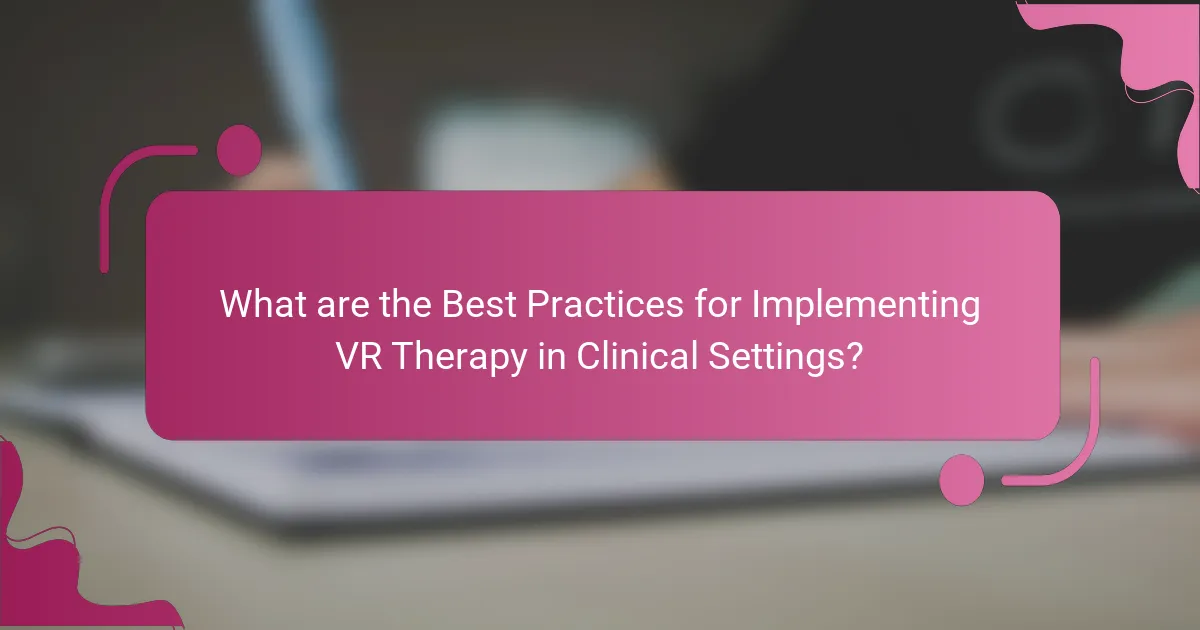
What are the Best Practices for Implementing VR Therapy in Clinical Settings?
The best practices for implementing VR therapy in clinical settings include thorough training for therapists, ensuring patient comfort, and utilising evidence-based protocols. Establish a clear therapeutic goal and customise experiences for individual needs. Regularly assess patient progress and adjust VR scenarios as necessary. Collaborate with technology experts to maintain equipment and software updates. Encourage feedback from patients to enhance the therapeutic experience.
How Can Therapists Effectively Utilize VR Tools in Sessions?
Therapists can effectively utilise VR tools by creating immersive environments tailored to individual phobias. This method enhances exposure therapy, allowing clients to confront fears in a controlled setting. Studies show that VR therapy can reduce anxiety levels by up to 60%. Additionally, therapists can track progress through data analytics, adjusting sessions based on real-time feedback. Engaging clients in these innovative experiences fosters a deeper connection, promoting mental wellness and resilience.
What Common Mistakes Should be Avoided When Using VR Therapy?
Common mistakes in VR therapy include inadequate preparation, neglecting individual differences, and failing to integrate feedback. Practitioners often overlook the importance of customising experiences for unique phobias, which can hinder progress. Additionally, not providing thorough orientation before sessions can lead to increased anxiety. Lastly, ignoring patient feedback during treatment can result in ineffective interventions, reducing the overall success of VR therapy for mental wellness.
What Future Trends Should Practitioners Watch in VR Therapy Innovations?
Practitioners should watch advancements in immersive technology, AI integration, and personalised experiences in VR therapy. Emerging trends include enhanced realism in simulations, adaptive exposure therapy protocols, and data-driven insights for mental wellness. These innovations aim to improve engagement and efficacy in treating phobias and anxiety disorders. For example, AI can tailor scenarios based on patient responses, leading to more effective treatment outcomes. Additionally, the use of biofeedback mechanisms in VR environments may provide real-time data to therapists, enhancing therapeutic interventions.
